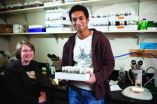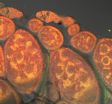(Press-News.org) A new ESF position paper calls for increasing use of ICT to deliver health and social care services.
A new position paper, Developing a New Understanding of Enabling Health and Wellbeing in Europe, published today by the European Science Foundation, highlights the need for change in health and social care across Europe.
As social care and informal care are essential to improving health and preventing health problems, especially in an ageing population, there are still large gaps of knowledge in how best to organise this, and how best to combine it with health care. The position paper sees Information and Communication Technologies (ICT), which are increasingly deployed in service sectors to enable consumer customisation and better resource management, as the way forward for improved healthcare.
The publication presents a vision for a new model of integrated care support for citizens' health through linked social and health care. It exposes current developments and challenges concerning demographic changes, ageing and established a concrete research agenda for ICT application focussing for instance on the relationship between patients and carers, the acceptability of ICT, the role of data, the organisation and legal aspects or the financing challenge.
Developing a New Understanding of Enabling Health and Wellbeing in Europe underlines that "Research programmes need developing at national and European level to stimulate a comprehensive and cohesive pattern of social science research into the means of achieving optimal ICT support as the enabler for a new integrated and partnership paradigm of health-related care".
It highlights a number of priorities for important advances to be made toward the harmonisation of healthcare delivery and informatics support:
Integrated delivery of health care and social care support of individual's health
Personalised care delivery including reasonable accommodation of individual choice
Ensure effective use of ICT applications based on user acceptability
Bring processes of consent, delegation, representation, coordination and privacy into the electronic era
Ensure respect for and teamwork with formal carers and the informal care team
Ensure equity in an electronic era regardless of digital literacy, assets and connectivity
Examine stable , sustainable models of trusted infrastructure provision
Establish governance, authentication, management, and sustainability principles.
This position paper is an outcome of the European Science Foundation's Exploratory Workshop 'The Challenges of Developing Social Care Informatics as an Essential Part of Holistic Health Care' held 21-23 July 2010 at Keele University (UK) with the participation of 23 international academics engaged in health care and informatics professions and disciplines together with legal, ethical, economist and patient interests.
###
The ESF Position Paper Developing a New Understanding of Enabling Health and Wellbeing in Europe is available online at: http://www.esf.org/publications.
Social scientists propose integrated information systems for smarter health and social care
A new ESF position paper calls for increasing use of ICT to deliver health and social care services
2013-02-05
ELSE PRESS RELEASES FROM THIS DATE:
Newly discovered plant structure may lead to improved biofuel processing
2013-02-05
Athens, Ga. – When Li Tan approached his colleagues at the University of Georgia with some unusual data he had collected, they initially seemed convinced that his experiment had become contaminated; what he was seeing simply didn't make any sense.
Tan was examining some of the sugars, proteins and polymers that make up plant cell walls, which provide the structural support and protection that allow plants to grow. Yet his samples contained a mixture of sugars that should not be present in the same structure.
However, Tan was convinced that his samples were pure so ...
A spiral galaxy with a secret
2013-02-05
Despite its appearance, which looks much like countless other galaxies, Messier 106 hides a number of secrets. Thanks to this image, which combines data from Hubble with observations by amateur astronomers Robert Gendler and Jay GaBany, they are revealed as never before.
At its heart, as in most spiral galaxies, is a supermassive black hole, but this one is particularly active. Unlike the black hole at the centre of the Milky Way, which pulls in wisps of gas only occasionally, Messier 106's black hole is actively gobbling up material. As the gas spirals towards the black ...
Kaiser Permanente's anti-obesity interventions in schools show signs of success
2013-02-05
OAKLAND, Calif., February 5, 2013 – Community-based efforts to change the environment are proving to be an effective way of encouraging more physical activity and nutrition among school-age children, according to findings announced today from Kaiser Permanente. Researchers examined a series of Kaiser Permanente community-based obesity prevention interventions in adults and children and found that the more effective obesity prevention interventions were those that were "high dose" – reaching large populations with greater strength – and those that focused specifically on ...
21 minutes to marital satisfaction
2013-02-05
EVANSTON, Ill. --- Marital satisfaction -- so critical to health and happiness – generally declines over time. A brief writing intervention that helps spouses adopt a more objective outlook on marital conflict could be the answer.
New Northwestern University research shows that this writing intervention, implemented through just three, seven-minute writing exercises administered online, prevents couples from losing that loving feeling.
"I don't want it to sound like magic, but you can get pretty impressive results with minimal intervention," said Eli Finkel, lead author ...
Achilles heel: Popular drug-carrying nanoparticles get trapped in bloodstream
2013-02-05
ANN ARBOR—Many medically minded researchers are in hot pursuit of designs that will allow drug-carrying nanoparticles to navigate tissues and the interiors of cells, but University of Michigan engineers have discovered that these particles have another hurdle to overcome: escaping the bloodstream.
Drug delivery systems promise precision targeting of diseased tissue, meaning that medicines could be more effective at lower doses and with fewer side effects. Such an approach could treat plaques in arteries, which can lead to heart attacks or strokes.
Drug carriers would ...
Biologists map rare case of fitness-reducing interaction in nuclear, mitochondrial DNA
2013-02-05
BLOOMINGTON, Ind. -- A team of biologists from Indiana University and Brown University believes it has discovered the mechanism by which interacting mutations in mitochondrial and nuclear DNA produce an incompatible genotype that reduces reproductive fitness and delays development in fruit flies.
The new research, led by IU biologists Kristi Montooth and Colin Meiklejohn and including former IU undergraduate researcher Mo Siddiq, describes the cause and consequences of an interaction between the two genomes that co-exist within eukaryotic cells. Animal mitochondrial ...
EARTH: Moon could have formed from Earth after all
2013-02-05
Alexandria, VA –Scientists are revisiting the age-old question of how Earth's moon formed with the development of two new models that work out the complicated physics of planetary collisions. The idea of a moon-forming collision is not new: The Giant Impact Theory put forth in the 1970s suggested that the moon resulted from a collision with a protoplanet approximately half the size of ancient Earth. But the physics underlying such a collision implied that the moon should be made up of debris mostly from the protoplanet. Since then we've discovered the moon is instead very ...
Mitochondrial mutations: When the cell's 2 genomes collide
2013-02-05
PROVIDENCE, R.I. [Brown University] — Diseases from a mutation in one genome are complicated enough, but some illnesses arise from errant interactions between two genomes: the DNA in the nucleus and in the mitochondria. Scientists want to know more about how such genomic disconnects cause disease. In a step in that direction, scientists at Brown University and Indiana University have traced one such incompatibility in fruit flies down to the level of individual nucleotide mutations and describe how the genetic double whammy makes the flies sick.
"This has relevance to ...
Old age offers no protection from obesity's death grip
2013-02-05
Obesity kills, giving rise to a host of fatal diseases. This much is well known. But when it comes to seniors, a slew of prominent research has reported an "obesity paradox" that says, at age 65 and older, having an elevated BMI won't shorten your lifespan, and may even extend it. A new study takes another look at the numbers, finding the earlier research flawed. The paradox was a mirage: As obese Americans grow older, in fact, their risk of death climbs.
Ryan Masters, PhD, and Bruce Link, PhD, at Columbia University's Mailman School of Public Health, in collaboration ...
Giving transplanted cells a nanotech checkup
2013-02-05
Researchers at Johns Hopkins have devised a way to detect whether cells previously transplanted into a living animal are alive or dead, an innovation they say is likely to speed the development of cell replacement therapies for conditions such as liver failure and type 1 diabetes. As reported in the March issue of Nature Materials, the study used nanoscale pH sensors and magnetic resonance imaging (MRI) machines to tell if liver cells injected into mice survived over time.
"This technology has the potential to turn the human body into less of a black box and tell us if ...
LAST 30 PRESS RELEASES:
Hematological and biochemical serum markers in breast cancer: Diagnostic, therapeutic, and prognostic significance
Towards integrated data model for next-generation bridge maintenance
Pusan National University researchers identify potential new second-line option for advanced biliary tract cancer
New study warns of alarming decline in high blood pressure control in England
DNA transcription is a tightly choreographed event. A new study reveals how it is choreographed
Drones: An ally in the sky to help save elephants!
RNA in action: Filming ribozyme self-assembly
Non-invasive technology can shape the brain’s reward-seeking mechanisms
X-ray imaging captures the brain’s intricate connections
Plastic pollution is worsened by warming climate and must be stemmed, researchers warn
Europe’s hidden HIV crisis: Half of all people living with HIV in Europe are diagnosed late, threatening to undermine the fight against AIDS
More efficient aircraft engines: Graz University of Technology reveals optimization potential
Nobel Prize-awarded material that puncture and kill bacteria
Michigan cherry farmers find a surprising food safety ally: falcons
Individuals with diabetes are more likely to suffer complications after stent surgery
Polyphenol-rich diets linked to better long-term heart health
Tai chi as good as talking therapy for managing chronic insomnia
Monthly injection helps severe asthma patients safely stop or reduce daily steroids
The Lancet Respiratory Medicine: Monthly injection may help severe asthma patients safely reduce or stop daily oral steroid use
Largest study reveals best treatment options for ADHD
Tsunami from massive Kamchatka earthquake captured by satellite
Hidden dangers in 'acid rain' soils
Drug developed for inherited bleeding disorder shows promising trial results
New scan could help millions with hard-to-treat high blood pressure
9th IOF Asia-Pacific Bone Health Conference set to open in Tokyo
Can your driving patterns predict cognitive decline?
New electrochemical strategy boosts uranium recovery from complex wastewater
Study links America’s favorite cooking oil to obesity
Famous Easter Island statues were created without centralized management
Captive male Asian elephants can live together peacefully and with little stress, if introduced slowly and carefully, per Laos case study of 8 unrelated males
[Press-News.org] Social scientists propose integrated information systems for smarter health and social careA new ESF position paper calls for increasing use of ICT to deliver health and social care services



